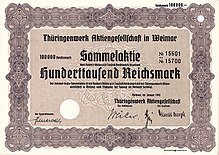Thuringia Works
| Thuringian state electricity supply AG | |
|---|---|
| legal form | Corporation |
| founding | October 17, 1923 |
| resolution | 1948 |
| Reason for dissolution | expropriation |
| Seat | Weimar |
| Branch | power supply |
The Thuringian state electricity supply company , better known under the abbreviation Thüringenwerk , was the supraregional energy supply company of the state of Thuringia from 1923 to 1948 .
history
Foundation and development
At the beginning of the 20th century, in the early days of electrification , the power landscape in Thuringia was highly fragmented, and a large number of urban and regional power plants operated smaller power plants and networks. In order to promote and coordinate the further development, the state of Thuringia, which had only come into being three years earlier, founded the Thuringia works in 1923 together with some leading private electricity companies as an overland plant for the state-wide network.
At the height of its expansion, the network of the Thuringia Works was about 570 kilometers in length. In addition to numerous private, municipal and regional suppliers in the state of Thuringia, the Thuringia factory also connected and supplied the southern part of the Erfurt administrative district of the Prussian province of Saxony with the districts of Erfurt and Weißensee (Gispersleben).
For the control and supply of the network, the Thuringia plant had 13 of its own transformer stations and four of its own power plants , including the formerly municipal large power plant in Erfurt (now Iderhoffstraße , formerly Radowitzstraße), the power plant of the Saale dam Bleiloch and, after the incorporation of Werrakraftwerke Aktiengesellschaft in 1932 the Spichra hydropower plant on the Werra . For electricity generation, the Thüringenwerk continued to hold stakes in power plant operators such as Kraftwerk Thüringen AG (operator of the Gispersleben power plant ) and cooperated with the Thüringer Elektrizitäts-Lieferungs-Gesellschaft (ThELG, subsidiary of AEG, operator of the Breitungen power plant ). The connection to neighboring networks and local distribution networks for purchase and delivery was also established via 15 external substations. There were electricity purchase agreements with AG Sächsische Werke (ASW) and Preußische Elektrizitäts-AG (from 1925 on a 60 kV coupling line between the Borken power plant of PREAG and the Breitungen power plant in Thuringia) and from 1936 with the Bayernwerk .
Dissolution and succession
After the end of the Second World War , Thuringia came under Soviet occupation. In 1948, the Thuringia factory, like many other companies, was expropriated by the Soviet Military Administration in Germany (SMAD). The plants (power plants, switchgear and transformer stations, lines ...) were converted into public property, which were run by various publicly owned companies . The companies of the state of Thuringia were combined in the southern district of VVB Energieversorgung , later in the southern energy combine and from 1979 in the Erfurt , Gera and Suhl energy combinations .
After the fall of the Wall and the subsequent reunification , the energy combines were privatized by the Treuhandanstalt . In Thuringia, the Energieversorgung Nordthüringen AG (ENAG), the Ostthüringer Energieversorgung AG (OTEV, Jena) and the Südthüringer Energieversorgung AG (SEAG, Meiningen) were founded. In 1994 these three merged to form TEAG Thüringer Energie AG, initially a subsidiary of Bayernwerk or E.ON , today Thüringer Energie AG.
literature
- Siegmar Neuhaus, Peter Glatz, Klemens Will: Das Thüringenwerk: a look back at the history of electricity in Thuringia . 2nd Edition. TEAG, 2003.
- Siegmar Neuhaus, Walter Schossig: The electricity supply in Thuringia . In: Horst A. Wessel (Ed.): From the line to the network (= history of electrical engineering ). tape 22 . VDE-Verlag, Berlin / Offenbach 2006, ISBN 978-3-8007-2969-2 .
- Hanno Trurnit: Thuringia in the current of time - How electricity helped the country and its people to have a better life . TEAG 1998, ISBN 3-00002669-X
Web links
- Working group on the history of electricity in Thuringia
- Early documents and newspaper articles on Thuringia in the 20th century press kit of the ZBW - Leibniz Information Center for Economics .
Individual evidence
- ↑ a b Neuhaus et al. 2003 (see literature)
- ↑ a b c Historical background. (No longer available online.) 50Hertz Transmission , archived from the original on January 22, 2012 ; Retrieved February 14, 2012 . Info: The archive link was inserted automatically and has not yet been checked. Please check the original and archive link according to the instructions and then remove this notice.
- ↑ a b Harald Mitteldorf: The history of the Saale dams (1890-1945) . Vopelius, Jena 2007, ISBN 3-939718-03-3 .
- ↑ Hans Rauchhaus (Working Group Electricity History, Thuringian Electric Museum Erfurt eV): The beginnings of electrical energy supply in Thuringia. Culture magazine Moment, January 7, 2010, accessed on February 14, 2012 .
- ^ Siegmar Neuhaus: The Spichra hydropower plant on the Werra, Thüringer Energie AG, 1998, page 15f.
- ^ Walter Schossig: 10 years electrical reunification of Germany . In: ew . No. 21-22 , 2005, pp. 80–83 ( full text as PDF ). Full text as PDF ( memento of the original from October 8, 2007 in the Internet Archive ) Info: The archive link was inserted automatically and has not yet been checked. Please check the original and archive link according to the instructions and then remove this notice.
